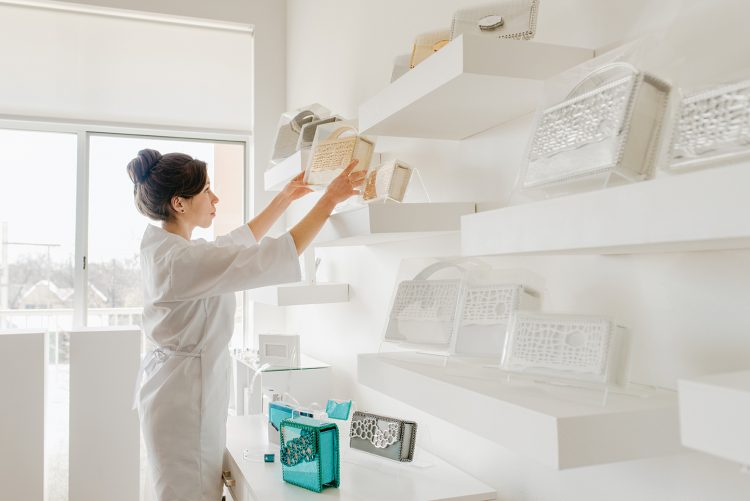
I attended a Montessori school that exposed me to the works of VanGogh and Picasso at a very young age. My mother taught my brother and me about art very early on, reading books about artists and taking us to art shows and antique shops, where we learned how to respect hand-crafted objects, viewing them closely and delicately touching the items when appropriate. In that sense, I quickly developed an appreciation for well-made, everyday objects as art.
My grandmother and mother taught me how to sew; I made quilts, pillows, and fabric bags with them throughout my adolescence. I loved sorting through my grandma’s big tin of buttons, and I always found ways to embellish or edit clothing with my limited sewing skills.
Like sculpture, I carefully construct each bag design from all angles with meticulous attention to the way material conveys emotion.
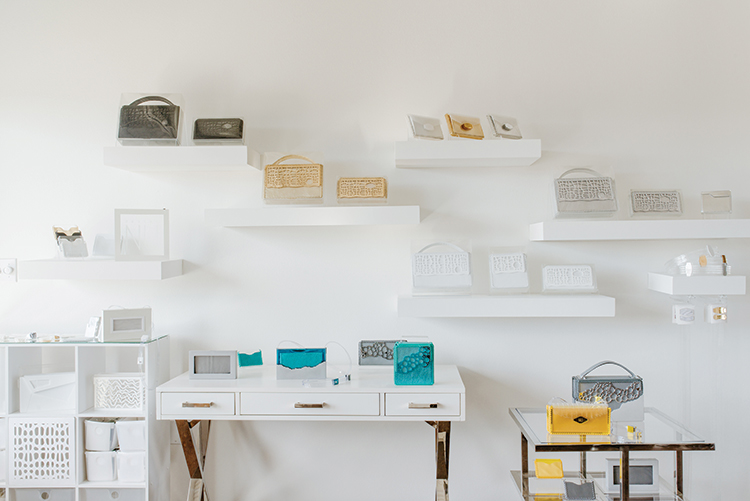
I’ve always loved fashion, and while in architecture school I researched designers like Alexander McQueen and Iris Van Herpen as inspiration for building projects. I was fortunate enough to take part in an incredible study abroad program in school that was based in Paris for a month. While in France, I made a solo trek to visit the Yves Saint Laurent exhibition at the Petit Palais, one of the biggest fashion retrospectives held in a museum that housed over 300 couture designs. That exhibition was a true moment of awe for me; I realized that a pursuit of fashion design would be the most inspiring, fulfilling, and emotive artistic path for me.
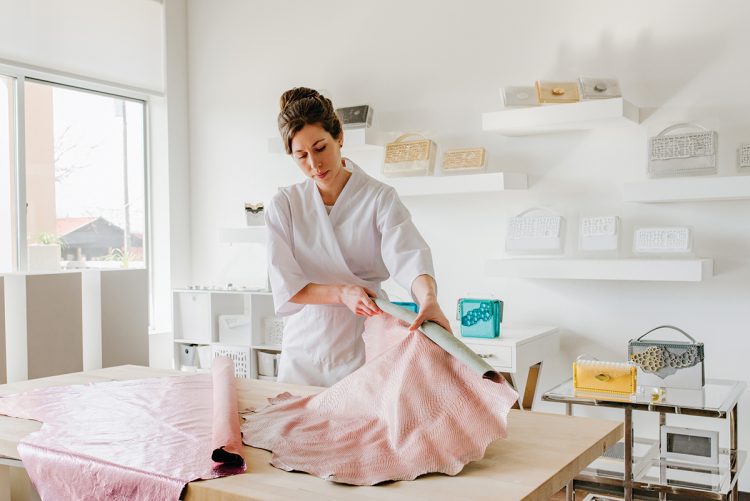
After college, I immersed myself in sewing classes, pattern drafting, and books on traditional leather craft techniques. Though I did make some clothing, I quickly gravitated toward making handbags because the scale and structure felt far more familiar and exhilarating coming from my architectural model-making background. For me, handbag design is an exciting marriage between fashion and sculpture.
While still in school, I held various barista jobs that I balanced with my studies. When I graduated from school and moved to Austin, I very much wanted to find access to a laser cutter to continue my experimental handbag designs. Fortunately, I quickly found a studio called MakeATX that is run by two like-minded women who were also introduced to laser cutting in architecture school, and they created a maker space that utilizes the laser cutters for non-architectural projects. I interned at MakeATX, and have been happily working there since 2013, where I specialize in handling custom cutting projects for other clients. Working at MakeATX has been such a pleasure and an opportunity for me to immerse myself in my craft and build my fabrication skill set. I utilize my expertise in laser cutting to teach classes and help other artists fabricate their designs. I have a heavy hand in all of the laser maintenance and really know these machines and their capabilities from the inside out.
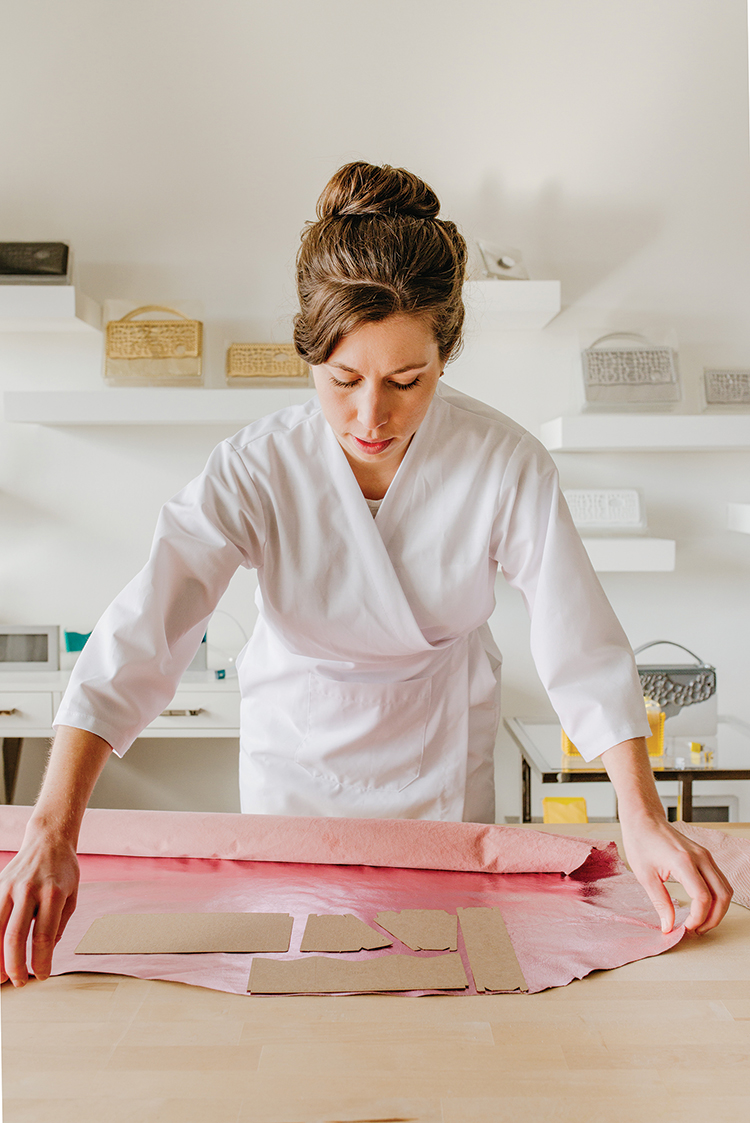
My brand Pascal NU handbags feature an unconventional combination of materials like concrete, acrylic, resin and leather. Most bags feature intricate hand lacing, fully lined leather interiors, and numbered acrylic hardware. All production takes place in-house and in limited quantities in order to break conventional constraints of mass production.
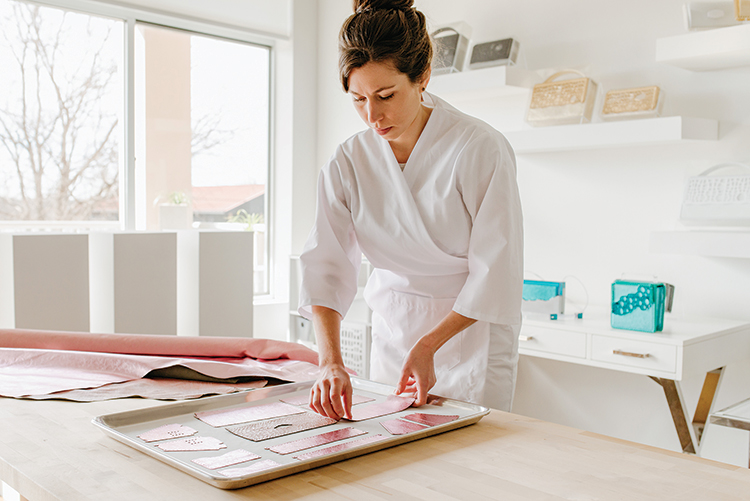
As far as the choice of materials I use, I fell in love with acrylic when I used it to make architectural models in school. I made one model that looked like a clear crystal building, with small colorful blocks dispersed on each floor. That model looked like a pristine gem and I immediately wanted to wear it!
I saw something extremely modern and compelling about clear acrylic.
I had also made a conceptual building model out of concrete that looked like a block of Swiss cheese, using plastic tubes to create holes and view chambers through the concrete. I definitely had an affinity for concrete—I saw a lot of potential in that material to introduce a new texture and characteristic to my bag designs in a way that felt excitingly unique and modern. So I began experimenting with concrete casting and honed in on that craft, which propelled me into more sophisticated mold-making techniques and resin casting. Leather, on the other hand, is such a versatile material; its density and variation is very appealing to me because it’s a more familiar building material.
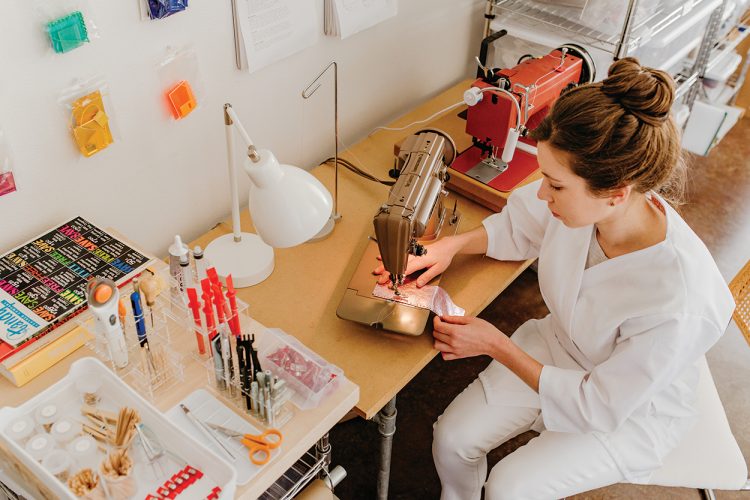
Leather can inherently hold its own structure, and is available in many different thicknesses, which can be molded into fairly rigid shapes or bend itself with delicate designs. I love the intricacy of hand-laced leather, an art that I learned from my grandpa and his old Tandy leatherworking books. I chose to incorporate PVC lacing for the edge binding of my handbags because it felt like the perfect material to tie in old world leather techniques with new age materials.
Every bag has been designed from scratch and assembled with a hybrid of digital fabrication and traditional leather craft techniques.
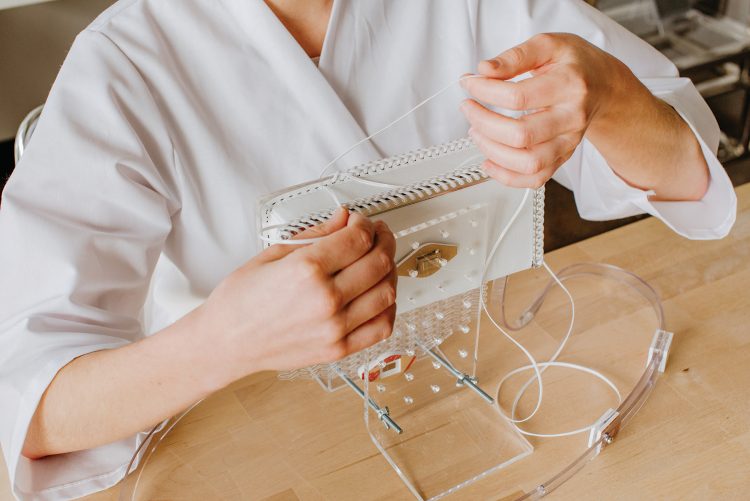
The inspiration for most of my bags starts with material palette. I approach bag designs by searching for ways to most embolden a rich color palette with emphasis on details and intricacy that showcase texture and surface quality. Most of the color palettes that I choose to design with are entirely monochrome, which allows the bags to highlight differences in material subtleties and more easily accent wardrobes.
My process begins by drafting a digital file for all of the intricate pattern pieces, though the conceptual design for the structure and geometry of the handbag start in my sketchbook. The digital file that I design contains all of the intricate lacing holes and perfected patterns, which I then laser cut out of leather and acrylic. Before I’m able to laser cut the leather, I arrange paper pattern pieces onto the leather hide so that I know how exactly to arrange the pieces that will be laser cut. After I laser cut the leather and acrylic, I begin sewing the leather pieces using one of my two sewing machines, depending on the stitch type that I need for that bag component. After sewing the leather and assembling the acrylic hardware for the bag, I can begin lacing the edges of the bag together. The hand lacing can be the most time-consuming task, but it’s also my favorite task because it means that I’ve gotten through the more difficult assembly components and I can enjoy the meditative flow of lacing.
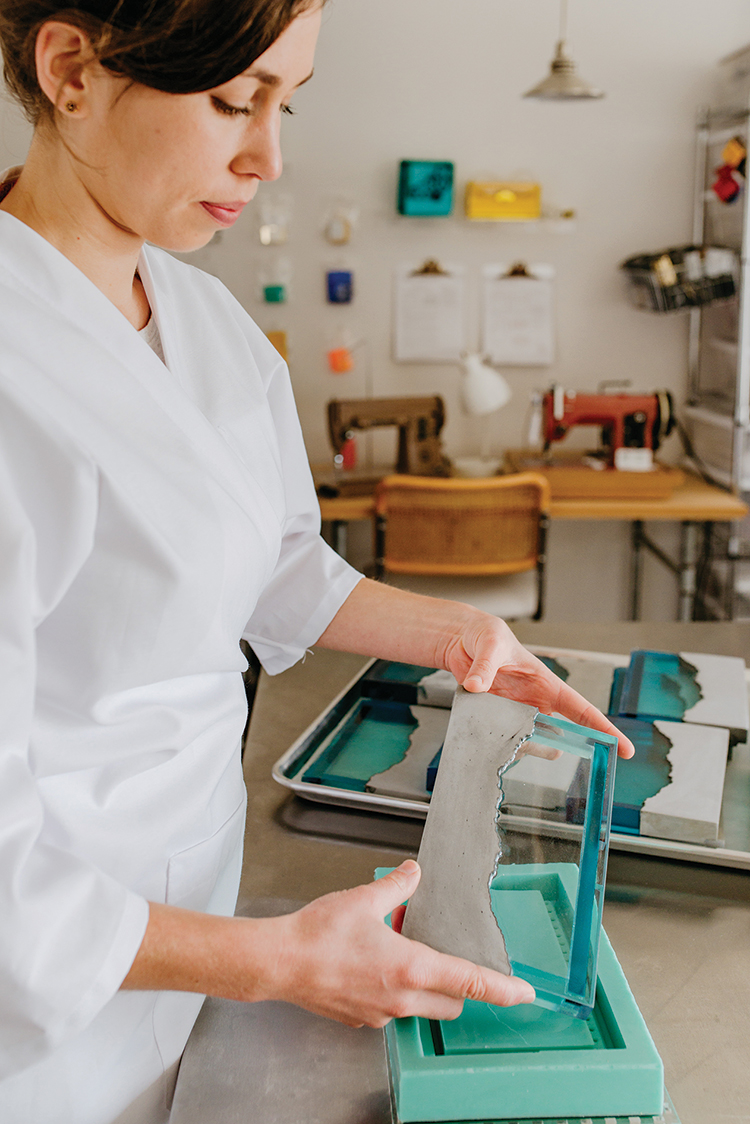
For my concrete and resin bags, I add the additional steps of creating the mold and formwork for the design, which tends to require extra prototyping until I’m able build the final mold. Once the mold is complete, I carefully mix the concrete and resin at specific quantities, adding dyes, and making sure that there are no bubbles forming throughout the casting process. Once those hand-cast pieces have hardened, I carefully sand and polish them before I begin to assemble them to the leather pieces.
The idea to make a concrete, resin, and leather bag felt like an ambitious but realistic goal; I had a clear vision of how the materials would look together and optimism that I’d eventually figure out a way to assemble it. The Tide Pool Bag is the result of that intuition, and after many months of troubleshooting, I’m extremely proud of that piece and the skill set that it has helped me build. I love the way the aqua resin sets off the grey concrete, with the metallic leather interior and mirrored teal hardware that create the illusion of an underwater gem.
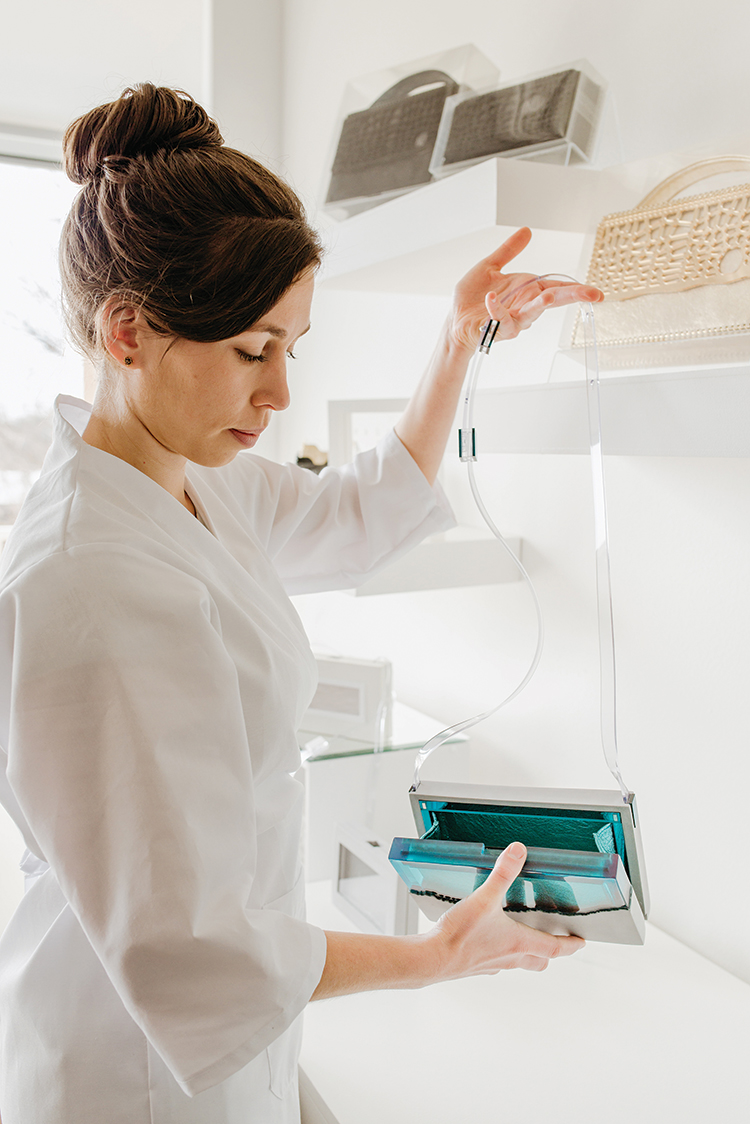
As I have mentioned, the materials are the guiding inspiration with all of my designs—it’s the time and focus that I put into understanding how to fabricate those materials in new ways that bring my creative visions to life.
The hand-laced edges of my bags bring intricate ornamentation to my modern designs, reflective of its time-consuming craft.

I attended a Montessori school that exposed me to the works of VanGogh and Picasso at a very young age. My mother taught my brother and me about art very early on, reading books about artists and taking us to art shows and antique shops, where we learned how to respect hand-crafted objects, viewing them closely and delicately touching the items when appropriate. In that sense, I quickly developed an appreciation for well-made, everyday objects as art.
My grandmother and mother taught me how to sew; I made quilts, pillows, and fabric bags with them throughout my adolescence. I loved sorting through my grandma’s big tin of buttons, and I always found ways to embellish or edit clothing with my limited sewing skills.
Like sculpture, I carefully construct each bag design from all angles with meticulous attention to the way material conveys emotion.

I’ve always loved fashion, and while in architecture school I researched designers like Alexander McQueen and Iris Van Herpen as inspiration for building projects. I was fortunate enough to take part in an incredible study abroad program in school that was based in Paris for a month. While in France, I made a solo trek to visit the Yves Saint Laurent exhibition at the Petit Palais, one of the biggest fashion retrospectives held in a museum that housed over 300 couture designs. That exhibition was a true moment of awe for me; I realized that a pursuit of fashion design would be the most inspiring, fulfilling, and emotive artistic path for me.

After college, I immersed myself in sewing classes, pattern drafting, and books on traditional leather craft techniques. Though I did make some clothing, I quickly gravitated toward making handbags because the scale and structure felt far more familiar and exhilarating coming from my architectural model-making background. For me, handbag design is an exciting marriage between fashion and sculpture.
While still in school, I held various barista jobs that I balanced with my studies. When I graduated from school and moved to Austin, I very much wanted to find access to a laser cutter to continue my experimental handbag designs. Fortunately, I quickly found a studio called MakeATX that is run by two like-minded women who were also introduced to laser cutting in architecture school, and they created a maker space that utilizes the laser cutters for non-architectural projects. I interned at MakeATX, and have been happily working there since 2013, where I specialize in handling custom cutting projects for other clients. Working at MakeATX has been such a pleasure and an opportunity for me to immerse myself in my craft and build my fabrication skill set. I utilize my expertise in laser cutting to teach classes and help other artists fabricate their designs. I have a heavy hand in all of the laser maintenance and really know these machines and their capabilities from the inside out.

My brand Pascal NU handbags feature an unconventional combination of materials like concrete, acrylic, resin and leather. Most bags feature intricate hand lacing, fully lined leather interiors, and numbered acrylic hardware. All production takes place in-house and in limited quantities in order to break conventional constraints of mass production.

As far as the choice of materials I use, I fell in love with acrylic when I used it to make architectural models in school. I made one model that looked like a clear crystal building, with small colorful blocks dispersed on each floor. That model looked like a pristine gem and I immediately wanted to wear it!
I saw something extremely modern and compelling about clear acrylic.
I had also made a conceptual building model out of concrete that looked like a block of Swiss cheese, using plastic tubes to create holes and view chambers through the concrete. I definitely had an affinity for concrete—I saw a lot of potential in that material to introduce a new texture and characteristic to my bag designs in a way that felt excitingly unique and modern. So I began experimenting with concrete casting and honed in on that craft, which propelled me into more sophisticated mold-making techniques and resin casting. Leather, on the other hand, is such a versatile material; its density and variation is very appealing to me because it’s a more familiar building material.

Leather can inherently hold its own structure, and is available in many different thicknesses, which can be molded into fairly rigid shapes or bend itself with delicate designs. I love the intricacy of hand-laced leather, an art that I learned from my grandpa and his old Tandy leatherworking books. I chose to incorporate PVC lacing for the edge binding of my handbags because it felt like the perfect material to tie in old world leather techniques with new age materials.
Every bag has been designed from scratch and assembled with a hybrid of digital fabrication and traditional leather craft techniques.

The inspiration for most of my bags starts with material palette. I approach bag designs by searching for ways to most embolden a rich color palette with emphasis on details and intricacy that showcase texture and surface quality. Most of the color palettes that I choose to design with are entirely monochrome, which allows the bags to highlight differences in material subtleties and more easily accent wardrobes.
My process begins by drafting a digital file for all of the intricate pattern pieces, though the conceptual design for the structure and geometry of the handbag start in my sketchbook. The digital file that I design contains all of the intricate lacing holes and perfected patterns, which I then laser cut out of leather and acrylic. Before I’m able to laser cut the leather, I arrange paper pattern pieces onto the leather hide so that I know how exactly to arrange the pieces that will be laser cut. After I laser cut the leather and acrylic, I begin sewing the leather pieces using one of my two sewing machines, depending on the stitch type that I need for that bag component. After sewing the leather and assembling the acrylic hardware for the bag, I can begin lacing the edges of the bag together. The hand lacing can be the most time-consuming task, but it’s also my favorite task because it means that I’ve gotten through the more difficult assembly components and I can enjoy the meditative flow of lacing.

For my concrete and resin bags, I add the additional steps of creating the mold and formwork for the design, which tends to require extra prototyping until I’m able build the final mold. Once the mold is complete, I carefully mix the concrete and resin at specific quantities, adding dyes, and making sure that there are no bubbles forming throughout the casting process. Once those hand-cast pieces have hardened, I carefully sand and polish them before I begin to assemble them to the leather pieces.
The idea to make a concrete, resin, and leather bag felt like an ambitious but realistic goal; I had a clear vision of how the materials would look together and optimism that I’d eventually figure out a way to assemble it. The Tide Pool Bag is the result of that intuition, and after many months of troubleshooting, I’m extremely proud of that piece and the skill set that it has helped me build. I love the way the aqua resin sets off the grey concrete, with the metallic leather interior and mirrored teal hardware that create the illusion of an underwater gem.

As I have mentioned, the materials are the guiding inspiration with all of my designs—it’s the time and focus that I put into understanding how to fabricate those materials in new ways that bring my creative visions to life.
The hand-laced edges of my bags bring intricate ornamentation to my modern designs, reflective of its time-consuming craft.
















